#110 Bill Reid’s legacy enhanced
Bill Reid Collected
by Martine J. Reid
Vancouver: Douglas & McIntyre, 2016, in collaboration with the Bill Reid Centre
$19.95 / 9781771621151
Reviewed by Victoria Wyatt
First Published March 28, 2017
*
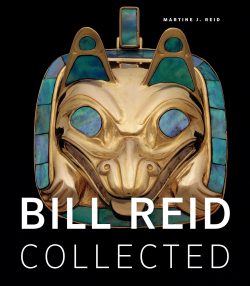 Much has been written about Bill Reid (1920-1998), the internationally known Haida artist whose monumental works appear in contexts such as the Canadian Embassy in Washington, DC, the Vancouver International Airport, and the village of Skidegate in Haida Gwaii.
Much has been written about Bill Reid (1920-1998), the internationally known Haida artist whose monumental works appear in contexts such as the Canadian Embassy in Washington, DC, the Vancouver International Airport, and the village of Skidegate in Haida Gwaii.
Reproductions of his sculptures circulate on the Canadian $20 bill. He left a mark as an author as well as an artist, writing essays and collaborating with co-authors of diverse specializations. A well-illustrated biography by Doris Shadbolt was published the year of his death. Other print and film resources explore his art. Today, Bill Reid enthusiasts command quick access to information and images online: a Google search for Bill Reid Haida artist produces over 120 relevant results.”

What of new value can one small paperback contribute to this ocean of attention? The answer, Bill Reid Collected demonstrates, is a lot. The book constitutes the third volume in Douglas & McIntyre’s “Collected” series. Previous titles celebrate Emily Carr (2013) and Ted Harrison (2015).
Following the series format, Bill Reid Collected presents an opus of elegant colour reproductions with minimal text, offered at an unusually low price for the quantity and quality of illustrations. It opens with “Bill Reid: Deeply Carved,” a 19-page essay by Dr. Martine J. Reid, the Honorary Chair of the Bill Reid Foundation.
As the late Bill Reid’s wife, she is intimately familiar with his creative activities. Reid organizes the essay into three periods: “Pre-Haida Phase (1948-1951): Toronto,” “Haida Phase (1951-1968): Vancouver,” and “Beyond Haida Phase (1968-1998): London (1968), Montreal (1969-1973), Vancouver (1973-1998).”
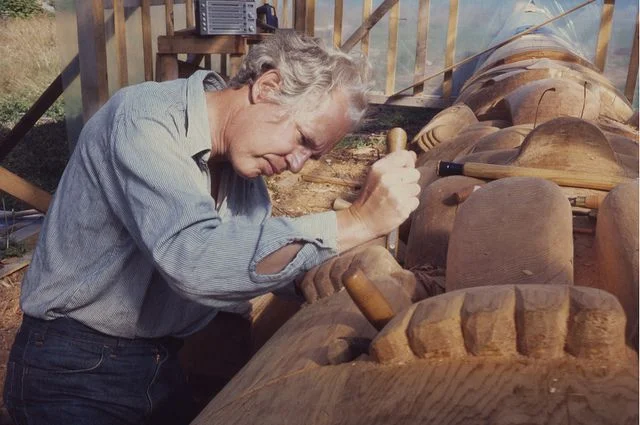
The essay concludes with a brief section on Bill Reid’s legacy. The writing is intentionally concise; the book exists for the images. Despite this economy, Martine Reid persuasively suggests the value of considering Bill Reid’s art in the context of phases in his life.
This focus on chronology invites the reader to think holistically about Bill Reid’s activities at each stage of his creative career. As he practiced in disparate materials and genres, one can be tempted to classify his works accordingly: jewellery, argillite, drawings, woodcuts, paintings, serigraphs, wood sculpture, monumental castings in bronze.
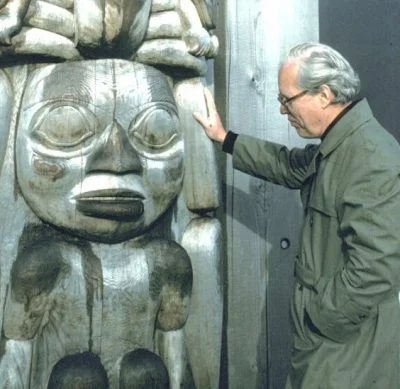
Groupings by such taxonomies facilitate analysis within genres but ignore relationships between genres. Martine Reid encourages us to consider Bill Reid’s creative activities through time, reflecting on how his artistic initiatives in each of the three phases manifest themselves in astonishingly diverse contexts.
“Bill Reid: Deeply Carved” leads into the heart of the book: 126 pages of colour plates of art works, organized chronologically from ca. 1932 through 1997. These spectacular photographs contrast dramatically with the plain white background. No argument or discussion interrupts the images; the sole text on each page is the title of the art work and its date.
Leafing through this gallery, the reader sees a compelling visual display of the tremendous diversity of materials and contexts in which Reid worked during each time period. The arrangement makes vivid the range of Reid’s creative interests and the ways his core values manifested themselves over time.
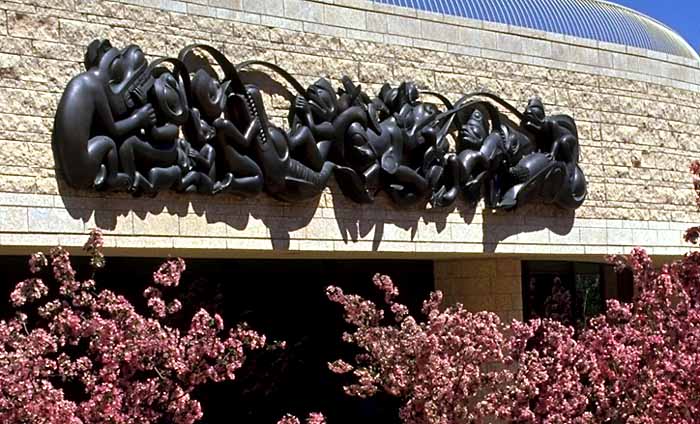
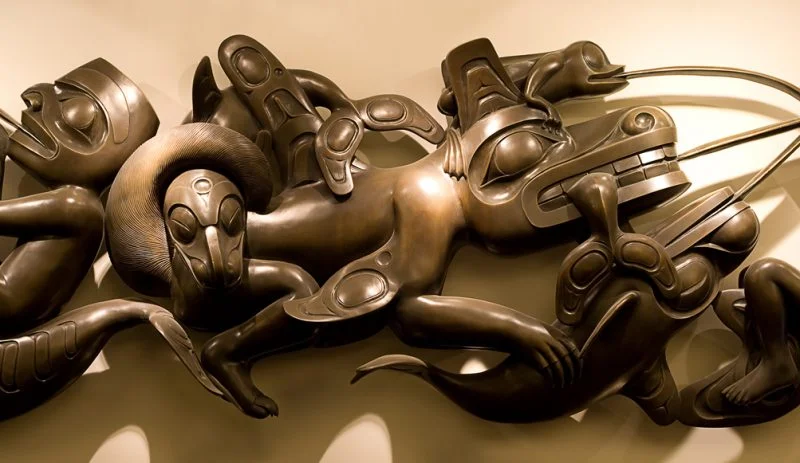
The design of the book respects the art works. Each enjoys its own page, with close-up images effectively lit to show details. Photographs may present multiple vantage points: a bracelet viewed from left, centre, and right, a brooch photographed both front and back to show an etched attribution to a design by Charles Edenshaw.
Only one work, the sculpture Mythic Messengers made for the façade of the Canadian Museum of Civilization in 1984, gets distorted by crossing the spine of the book. This was unavoidable given its long horizontal dimensions. Otherwise, the paperback permits images of generous size in a lightweight format that is pleasant to hold.
The unexpected diversity of the art works arranged chronologically generates interest: a silver bracelet faces a gold and shell pendant, a gold bracelet faces a bichrome woodcut, a pendant of silver, shell, and fossil ivory faces a metallic wire sculpture.
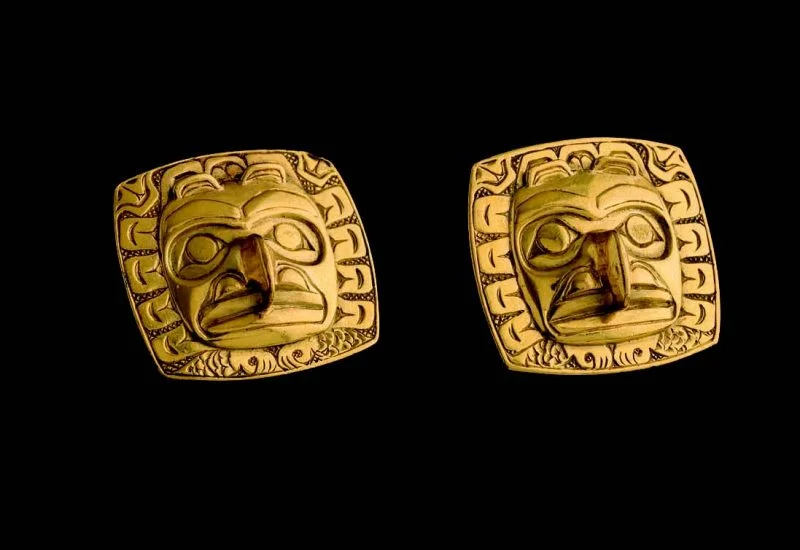
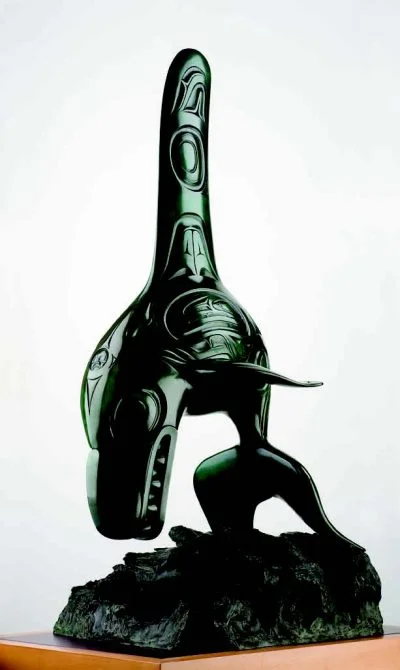
This visual parade highlights the vast range of Reid’s virtuosity in a way no written statement can. The lack of text heightens the aesthetic impact. Readers who want basic information about each art work will find it in the list of works following the section of images. Organized by page number, that list provides title, date, materials, size, current location, and photo credit.
An argument could be made for including the dimensions with each image to help the reader imagine actual size, especially as the chronological presentation juxtaposes small jewellery with much larger art works. Still, minimal text keeps attention on the visual impact of the photographs.
The physicality of print books offers a more tangible experience than on-line viewing, but definite drawbacks exist. Audiences accustomed to having several browser windows open for comparisons will miss those capabilities. It would be helpful to be able to move back and forth between the essay with its description of the three phases and the photos of art works in each phase. Similar sculptures and casts created in different years appear pages apart, making comparative analysis difficult.

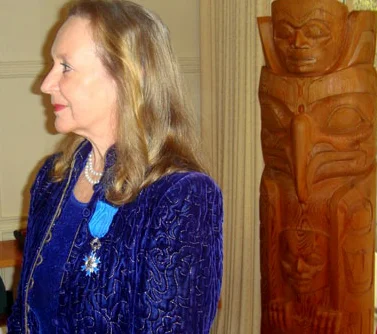
This frustrates in part because of surprising reiterations: for instance, the huge bronze façade Mythic Messengers mentioned above reappears ten years later in the form of a gold bracelet. Likewise, tracking change and continuity over Reid’s career remains impressionistic when one views a single image at a time.
To refer to materials, size, or dimensions, one must flip to the list of works. Readers interested in these various types of cross-referencing should seriously consider purchasing two copies of the book. Its relatively low cost makes this more feasible, while the quality of its photographs justifies the choice.
Bill Reid Collected contributes by presenting images in a new way. Seeing so many diverse art works in chronological order, structured with Martine Reid’s characterization of phases, reveals relationships that more conventional categorizations obscure. This presentation conveys a greater holistic understanding of the creative life of the artist. In so doing, it enhances understanding of his art.

*

A settler Canadian, Victoria Wyatt teaches in the Department of Art History & Visual Studies at the University of Victoria in Victoria, B.C. Her courses explore creative responses of Indigenous artists to colonialism in North America from the eighteenth century to the present, with a focus on the Northwest Coast. She encourages extensive analysis of the Internet as a resource for diverse voices and as a non-linear form of communication. In her research, she is interested in similarities between Indigenous Ways of Knowing and the recent paradigm shift in Western sciences that embraces processes and relationships within dynamic non-linear systems (e.g., neurobiology, quantum physics, epigenetics, climate science). She believes non-linear, holistic thinking that celebrates invisible interconnections is vital to addressing global challenges today. She holds a doctorate from Yale University and an honorary doctorate from Kenyon College.
*
The Ormsby Review. More Books. More Reviews. More Often.
Publisher and Editor: Richard Mackie
The Ormsby Review is a journal service for in-depth coverage of B.C. books and authors. The Advisory Board consists of Jean Barman, Robin Fisher, Cole Harris, Wade Davis, Hugh Johnston, Patricia Roy, David Stouck, and Graeme Wynn. Scholarly Patron: SFU Graduate Liberal Studies. Honorary Patron: Yosef Wosk. Provincial Government Patron since September 2018: Creative BC
“Only connect.” – E.M. Forster
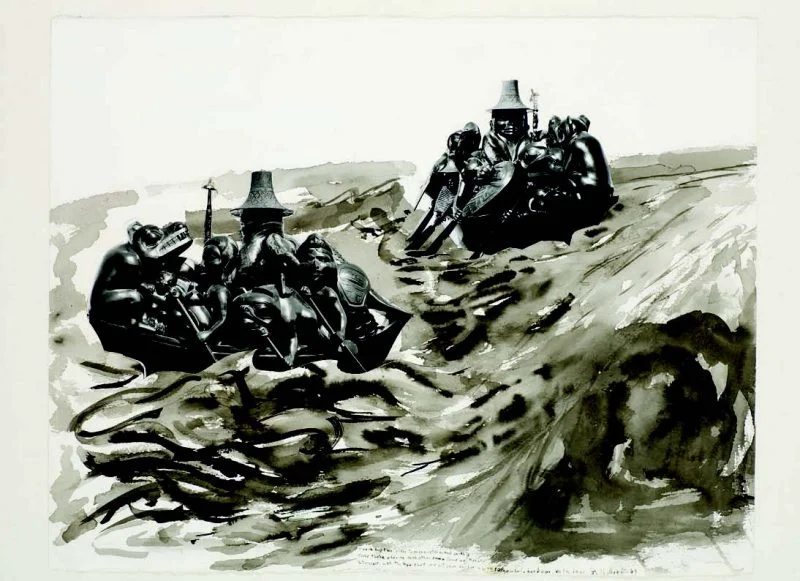































Comments are closed.